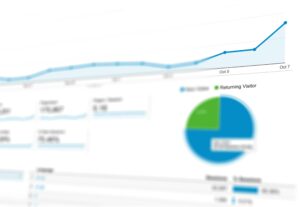Leveraging AI for e-commerce
This article outlines the possible ways of how e-commerce businesses (both the existing and the new ones) can benefit from Artificial Intelligence.
It is important to point out that this article is only a summary of the basic capabilities of Artificial intelligence in e-commerce. We created it to give you a better understanding of what Data Science can do for your business, and how it is already applied by companies in your industry.
To find out how Data Science can solve the challenges of your particular company, we need to see the whole picture and work with your data. The best way to do it is during an individual consultation.

Chatbots
Many online-stores have proven that chatbots can significantly boost your customer experience, providing round-the-clock support, some level of customization and lower expenses.
On the downside, most of the chatbots that are currently in use, are based on a decision-tree logic, often limiting their intelligence to simple generic answers. But conversations with customers rarely go the way you thought they would, right? And when a customer breaks the pattern, such chatbots don’t have the needed answers.
This is exactly the kind of problem that Deep Learning and Natural Language processing can solve. Chatbots programmed with the help of Data Science can learn and evolve over time, providing deeper, insightful responses and more human-like conversations. With the ability to learn, chatbots can not only sound more realistic, but they can also find out more about your users and their real needs and be able to generate highly-targeted offers and recommendations.
Smart Product Recommendations
AI engines are the fastest known way to process customer data. Unlike any human, they are thorough, tireless and can process large volumes of data in relatively little time.
When connected to your e-commerce portal, AI engines can collect and analyze data about your customer behavior, helping to better shape your customer journey, detect weak spots, spot patterns and predict tendencies.
By means of analyzing the customer’s preferences, browsing habits, buying history and current searches, Artificial Intelligence can make smart recommendations tailored to every specific customer. This personalized approach combined with improved customer experience results in better conversion and retention rates. Customers will want to return to your site for more purchases, because they’ll know you have what they need, thus bringing you more sales, more revenue, and faster inventory turnover.
The insights such an engine will generate about your customers will help you make smarter data-backed strategic decisions, improve your communications, better target your ad and email campaigns.
Intelligent Searches
In offline stores interaction with customers is key. A good Sales Assistant will talk to the customers, and relying on their needs and his experience, will suggest where to look for things customers are searching for. Even when they are not sure what those might be. What if online-stores could do the same, and do it with thousands of customers requiring minimum manual input?
AI engines are constantly learning and gaining their own experience to rely on while making suggestions to customers. Using lessons learned from the previous customers, AI systems make offers that reflect not only the existing needs but also the predicted ones. Personalized search results help take care of your online buyers, maximize Sales, improve your website SEO and bring your customer profiling in Marketing and Upsales to a totally new level.
Warehouse Automation
Labor expenses constitute up to 70% of warehouse maintenance costs. Self-taught machines can help automate many repetitive operations, tirelessly work 24/7 and learn to be precise and accurate, relieving the strain on large enterprises.
Retailers now don’t have to manually evaluate the financial data, AI can calculate how to organize your purchasing in the most efficient way or how to choose the special offer from providers that you will benefit from the most. MindCraft has developed a solution for one of our customers in Retail that can do just that, learn more details here.

Post-Sale Support
The Sales process doesn’t stop after one purchase. Customers who have already bought something from you once and were satisfied should be nurtured and encouraged to come back. Customers who were not satisfied, should not have their complaints unanswered. And unless you have only a few customers and a team of account managers to handle them, the load of work is quite tangible. Especially when all your customer relationship personnel is more focused on gaining new clients. So why not entrust the task to an AI-powered system?
Nowadays you can keep track of all your customers, set up automatic follow-ups, teach your system to process and respond to complaints, handle refunds, returns, and warranty claims. Moreover, you can automatically send special offers customized to the customers you already know, and generate limited-time offers to drive more sales, while also staying in touch with your existing customers.
Automated Inventory Management
Inventory management is one of the aspects of e-commerce that can easily be automated with the help of AI. After collecting data from cameras and sensors, databases, previous, current and estimated Sales, AI systems can automatically detect and fill shortages, identify and predict customer demand and items sitting idle.
Modern technology can go even further than that and analyze external factors that will influence your processes, such as weather conditions that can delay deliveries, changes in the market demand, or economic changes, that might affect your Sales.
AI-Based Sales Forecasting
Forecasting is something that Machine Learning and Artificial Intelligence technologies totally shine at, as no human would ever be able to process the equal volume of Big Data and still be able to spot indicators and tendencies.
The AI engine, on the other hand, can be trained to make conclusions based even on multiple sources of information. And it’s not only about seasonal changes, but it’s also the data about your previous Sales, information about your competitors, the general customer search trends and big changes in economics and society. To get a better idea of such a system, read about a Sales Forecasting Tool that we developed for one of our clients in Automotive.
Pricing Optimization
Artificial Intelligence can help you be smarter with your pricing. Taking into account numerous factors (e.g. cross-price and cross-promotional elasticity), self-taught systems can calculate the optimum prices for your goods with regard to the current date and time, the state of market demand, the customer’s geographic location and their buying habits.
AI can calculate the highest price your customers are able to accept to buy the product. The prices can differ from customer to customer. Even the same customer can see another price at a different point in time.
Analytics
All of the solutions we mentioned above touch upon analytics, one way or the other. In any business, especially in Retail, data holds plenty of invaluable insights, that can step up your game or tank your business whatsoever if you don’t catch them in time.
In addition to customer profiling, Sales Analysis, and forecasting, analyzing market demands and customer behavior, AI reveals your weak spots and potential risks to be aware of, shows the most and the least profitable activities and does all of that in real-time and with minimum need for human supervision. As they say, warned means armed, right?
Where to look for all this data? Google Analytics!
Google Analytics is a proven leader in the web analytics domain. Despite being free, it provides many indicators and metrics for your business: traffic and its sources, conversions, customer journey, time on site, operating systems, devices and screen resolutions of your users, to name a few. We won’t get into much detail. Here you can learn about how it works, here is a list of all the properties collected by Google Analytics, and this is a list of all events in customer behavior that you can track with this powerful tool.
To start using all this data, you should set everything up and give the system some time to start tracking. In the end, you’ll be able to not only learn about each and every customer session but also detect patterns and download easy-to-read reports with all KPIs relevant for your business. To retrieve and store data from Google Analytics, you can use various ways: Google Analytics API, OWOX BI Pipeline, Google BigQuery, and others.
It does have some shortcomings though. For example, if you are using a free version of GA, it takes 24-48 hours for the system to process the needed data. Also, the number of lines is quite limited and reports can only contain a certain number of parameters and indicators. Besides, you should be careful with sampling, as it might distort your data and lead to wrong business decisions.
Conclusion
Once you’re all set up with data collection, the amount of data is sufficient and the collection is expanded to UserID, ClientID, etc, we can move the data from Google Analytics and select the most efficient way to process all these data. The next steps would look like this:
- You need to increase data collection, add certain criteria if needed
- We’ll select the system and settings to store and download data
- We will need at least 3 months worth of information
- Our team of data scientists will analyze the data
- We’ll recommend which AI engine can be used in your particular case
If you have questions about what AI can and cannot do and which challenges we can deal with, please reach out to us at team@mind.local and schedule an individual consultation.




